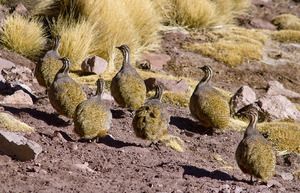Puna tinamou facts for kids
Quick facts for kids Puna tinamou |
|
|---|---|
 |
|
| Conservation status | |
| Scientific classification | |
| Genus: |
Tinamotis
|
| Species: |
pentlandii
|
 |
|
The puna tinamou (Tinamotis pentlandii), also known as Pentland's tinamou, is a special type of bird found in the high mountains of southern South America. It belongs to a very old group of birds called tinamous. This bird was named after an Irish scientist, Joseph Barclay Pentland, by Nicholas Aylward Vigors in 1837. The puna tinamou is doing well in its natural home, covering a large area of about 590,000 square kilometers (228,000 sq mi).
What is a Puna Tinamou?
The puna tinamou is a unique bird that is part of the Tinamidae family. All tinamous are also considered ratites. Ratites are a group of birds that mostly cannot fly, like ostriches or emus. However, tinamous are different because they can fly! They might not be the strongest fliers, but they can definitely take to the air. Scientists believe that all ratites came from birds that could fly a very long time ago. Tinamous are the closest living relatives to those ancient flying birds.
Appearance and Features
The puna tinamou is about 41 centimeters (16 inches) long. Its back and upper parts are brown with white spots, which helps it blend in with its surroundings. Its chest is a pretty blue-grey color, and its belly is a reddish-brown. The head of the puna tinamou is white with black stripes, giving it a distinctive look.
Where Puna Tinamous Live
Puna tinamous live in high-altitude areas in South America. You can find them in places like Peru, northern Bolivia, northern Chile, and northwestern Argentina. They prefer to live in grasslands that are very high up, usually between 4,000 to 4,700 meters (13,000 to 15,400 feet) above sea level. They also sometimes live in areas with small bushes. These birds are well-adapted to the cool, thin air of the mountains.
See also
 In Spanish: Perdiz de la puna para niños
In Spanish: Perdiz de la puna para niños


